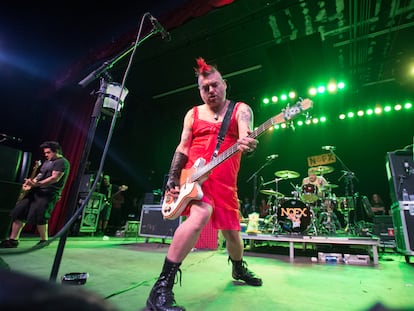This is MAVE: the K-pop avatar group with millions of views
The ‘band’ participates in TikTok challenges, perform their own choreographies and make appearances on television shows
SIU:, ZENA:, TYRA:, and MARTY: these are the names of the four members of the South Korean pop group MAVE:, which debuted last January with the song PANDORA. They are aged between 19 and 20 and each comes from a different country, including the U.S. and Indonesia, although they all have Asian features, as is common in the South Korean entertainment industry. Their first video clip garnered more than 20 million views, while their Spotify account has more than 1.5 million monthly listeners. In March, they appeared on the music program Show! Music Core, broadcast on the MBC TV channel, like any other K-pop group promoting their new single. The members have participated in TikTok challenges and recently celebrated 100 days since their debut. However, besides the numbers and the accompanying achievements, what is most surprising about this group is that they are avatars. Thanks to AI, 3D technology, augmented reality and voice synthesis, these virtual singers can pass for a conventional pop group, sometimes hardly distinguishable from a human one, especially when it comes to the singing.
The name MAVE: comes from ‘make new wave’ or meta wave, as the group has the “ambition to create a new wave in the K-pop scene during the metaverse era.” It is common for the names of Korean pop groups to indicate something about each member — maybe what they intend to achieve with their music or what they want to convey. Similarly, the names of their fans, which are also established by entertainment companies, have a meaning and a relationship to the group in question. In this case, MAVE:’s fans are called MAZE: because, together with the group, “they will blaze a new trail, a maze, one where no one has ventured yet, with the unshakable belief that they will find a way out as long as they stay together.”
Sung-Ku Kang, chief technology officer of Metaverse Entertainment, the company in charge of the group, explains to EL PAÍS that the project involves the same planning and production as is needed with real groups. “The members of the company are experts in various areas, such as video games, entertainment, and music,” he explains. “And they have a deep understanding of how to achieve good results and create endearing characters.”
But what can an avatar group offer that a human group can’t? As Kang says, “as a virtual group, you can choreograph with a speed and level of difficulty that would be difficult for a real singer to achieve, and you can draw on all kinds of imaginary scenarios when creating music videos.” He also points out that members of conventional groups often have different talents creating a disparity between them, while virtual idols don’t have to deal with that. They also have the obvious advantage of being able to be in several places at the same time. “They can perform in Korea and an hour later in the U.S., or directly in front of fans around the world at the same time,” says Kang.
However, when watching them perform, the viewer might be tempted to wonder whether real singers, in fact, lie behind so much technology. As far as appearance is concerned, their faces are not based on any specific person. They were created with “idol-type appearances and manually modified.” The origin of their singing skills lies in a mix of real actors’ vocals and AI generated voices, so they are “trained” to speak as the actors do. Kang explains that they will continue to use this mix, depending on the situation, but with the goal of increasing the use of AI-generated voices.

What appears to require the most work is getting the choreography to resemble one performed by humans. “It takes a lot of effort to get a virtual performer to move as naturally as a human,” says Kang. “To make the movements natural, we use motion-capture technology to record the movements of real people very accurately, and simulation technology to make the clothes and hair also move naturally.” But this wouldn’t be enough without expert filming: to shoot the PANDORA music video, an eight-meter-high, 20-by-20-meter-wide studio was used with motion-capture equipment and cameras of all kinds to record the movements in the same way as in a real music video. “That allowed us to see how the actors interacted naturally with the cameras and, also, to do post-production and editing with what we had recorded,” Kang adds.
As well as recording content, MAVE: members can interact in real time. Kang clarifies that this is not unlike what virtual YouTubers do. “Our goal is to create an emotional, memorable and long-term connection with each fan, rather than simply having a chat bot service,” he says, referring to what’s on offer now. Besides virtual intelligence and the other techniques mentioned, technologies needed to create this group include machine learning, 3D modeling, various simulation techniques to control facial and body movements, augmented reality and virtual reality, especially for virtual concerts and for interactions with fans, data analytics and cloud technologies.
Metaverse Entertainment, a subsidiary of video game developer Netmarble, is the company in charge of the project, which also includes Kakao Entertainment, the entertainment company that owns the Korean WhatsApp, Kakao Talk, several agencies for K-pop groups and actors, the music streaming service Melon and a huge platform of Webtoons — comics in vertical format that are very popular everywhere, but especially in Asia. More than 100 professionals have been involved in MAVE;’s creation and activities, and many of them have worked with or usually work with flesh-and-blood artists. PANDORA was composed by Maxx Song and Kyler Niko, who have produced songs for some of the industry’s best-known groups, such as Seventeen, Red Velvet and Monsta X; the music video director, Flipevil, has been in charge of IU, the country’s most successful solo artist; and the choreography was done by Freemind, choreographer of two of the group IVE’s biggest hits.
MAVE: is not the first South Korean music group formed by avatars, but it has had the greatest impact to date. In 2021, Superkind was launched, in which only one of the members is an avatar, and in the case of the members of Eternity, who debuted the same year, the company Pulse9 used technology it calls Deep Real AI, with which it claims to create “realistic faces regardless of race, age or gender.” However, virtual singers originated in Japan, in 2007, with Hatsune Miku, a hologram that has managed to offer fans live concerts.
Sign up for our weekly newsletter to get more English-language news coverage from EL PAÍS USA Edition
Tu suscripción se está usando en otro dispositivo
¿Quieres añadir otro usuario a tu suscripción?
Si continúas leyendo en este dispositivo, no se podrá leer en el otro.
FlechaTu suscripción se está usando en otro dispositivo y solo puedes acceder a EL PAÍS desde un dispositivo a la vez.
Si quieres compartir tu cuenta, cambia tu suscripción a la modalidad Premium, así podrás añadir otro usuario. Cada uno accederá con su propia cuenta de email, lo que os permitirá personalizar vuestra experiencia en EL PAÍS.
¿Tienes una suscripción de empresa? Accede aquí para contratar más cuentas.
En el caso de no saber quién está usando tu cuenta, te recomendamos cambiar tu contraseña aquí.
Si decides continuar compartiendo tu cuenta, este mensaje se mostrará en tu dispositivo y en el de la otra persona que está usando tu cuenta de forma indefinida, afectando a tu experiencia de lectura. Puedes consultar aquí los términos y condiciones de la suscripción digital.
More information
Últimas noticias
Most viewed
- Oona Chaplin: ‘I told James Cameron that I was living in a treehouse and starting a permaculture project with a friend’
- Reinhard Genzel, Nobel laureate in physics: ‘One-minute videos will never give you the truth’
- Sinaloa Cartel war is taking its toll on Los Chapitos
- Why the price of coffee has skyrocketed: from Brazilian plantations to specialty coffee houses
- Silver prices are going crazy: This is what’s fueling the rally












































